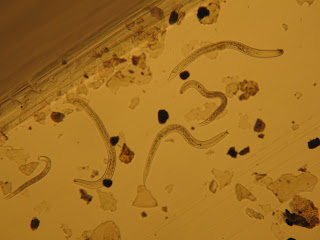This morning, we had to be at the post office building in McMurdo at 2:30 AM for transport. After an hour-long ride in the back of a large vehicle called a Delta, we made it out to the Pegasus Ice Runway. For some reason, they like to get you out to the runway super early so the plane wasn't even there yet. We got to the runway at about 3:45 AM and the plane finally got there at 4:15. It was fun to watch a huge plane like the C-17 land on an ice runway though.
 |
| C-17 touching down at Pegasus |
 |
| Finishing up the loading of the plane with cargo while the crowd waits to board |
 |
| Waiting for 2 hours to board |
 |
| Looking forward from my seat |
Even though we were technically considered to have been in New Zealand the whole time as far as our visa status goes (you don't need a passport to go to the continent of Antarctica), we still had to go through customs and New Zealand's biosecurity when we got back. Another flight arrived from Singapore at about the same time so the lines for both of them were long.
After we finished up, we headed over to the Clothing Distribution Center to change out of the Extreme Cold Weather gear we were required to wear for the flight and to return all of the gear that we had borrowed before we left. I feel like I'm traveling light now that I got rid of all of that stuff!
Since then, we've checked in to our hotel (I'm staying within walking distance of the airport), had lunch at the International Antarctic Centre (I guess we can't get enough of Antarctica!), and now I think we're going to go for a swim! It's nice to have plants outside and birds chirping! It looks like Byron is going to take off tonight to head up to Auckland. He's staying in New Zealand for a sabbatical so this will probably be the last time I see him.
While we were on the flight up here, one of the travel agents booked me for my flights. I leave tomorrow for home but won't get there until Tuesday evening.










































